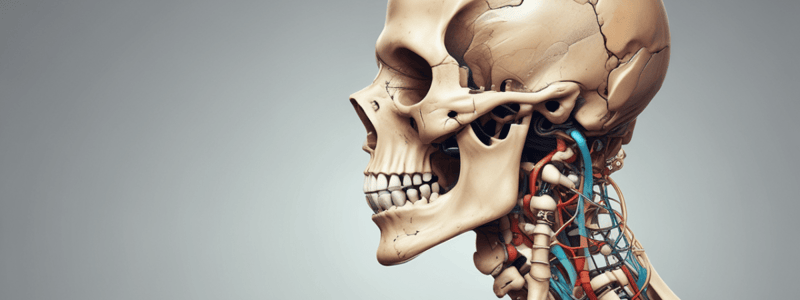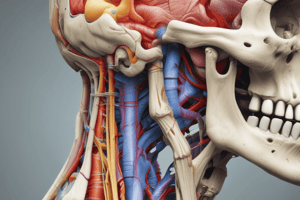Podcast
Questions and Answers
What is the superior bony articular surface of the temporomandibular joint?
What is the superior bony articular surface of the temporomandibular joint?
- Condylar process
- Articular tubercle of the temporal bone (correct)
- Head of the mandible
- Mandibular fossa
What type of cartilage covers the articular surfaces of the temporomandibular joint?
What type of cartilage covers the articular surfaces of the temporomandibular joint?
- Hyaline cartilage
- Elastic cartilage
- Fibrocartilage (correct)
- None of the above
What structure divides the temporomandibular joint cavity into upper and lower cavities?
What structure divides the temporomandibular joint cavity into upper and lower cavities?
- Synovial membrane
- Ligaments
- Fibrocartilaginous articular disc (correct)
- Articular capsule
Which of the following is NOT a characteristic of the temporomandibular joint?
Which of the following is NOT a characteristic of the temporomandibular joint?
What is the function of the temporomandibular joint?
What is the function of the temporomandibular joint?
Which of the following is NOT directly visualized in the anatomical and CT images of the TMJ?
Which of the following is NOT directly visualized in the anatomical and CT images of the TMJ?
What is the primary purpose of obtaining images of the TMJ in both the closed- and open-mouth positions?
What is the primary purpose of obtaining images of the TMJ in both the closed- and open-mouth positions?
Which of these options is MOST closely related to the innervation of the TMJ?
Which of these options is MOST closely related to the innervation of the TMJ?
What is the significance of understanding the innervation of the TMJ?
What is the significance of understanding the innervation of the TMJ?
Which type of imaging technique is MOST commonly used to visualize the TMJ?
Which type of imaging technique is MOST commonly used to visualize the TMJ?
What is the primary function of the venous plexus in the posterior aspect of the joint?
What is the primary function of the venous plexus in the posterior aspect of the joint?
How does the venous plexus in the posterior aspect of the joint respond to protrusive movements?
How does the venous plexus in the posterior aspect of the joint respond to protrusive movements?
What happens to the venous plexus in the posterior aspect of the joint during retrusive movements?
What happens to the venous plexus in the posterior aspect of the joint during retrusive movements?
What is the significance of the alternate filling and emptying of the venous plexus?
What is the significance of the alternate filling and emptying of the venous plexus?
Which of the following is NOT a function of the venous plexus in the posterior aspect of the joint?
Which of the following is NOT a function of the venous plexus in the posterior aspect of the joint?
What is the primary function of the muscles of mastication in relation to the TMJ?
What is the primary function of the muscles of mastication in relation to the TMJ?
Which of the following movements can occur at the temporomandibular joint?
Which of the following movements can occur at the temporomandibular joint?
In what context does rotation occur in the TMJ?
In what context does rotation occur in the TMJ?
Which statement about the movements of the mandible is incorrect?
Which statement about the movements of the mandible is incorrect?
Which of the following best describes how the mandible is elevated?
Which of the following best describes how the mandible is elevated?
What is the articular disk primarily composed of?
What is the articular disk primarily composed of?
What feature of the articular disk allows it to withstand pressure?
What feature of the articular disk allows it to withstand pressure?
What is the primary function of the articular disk in the temporomandibular joint?
What is the primary function of the articular disk in the temporomandibular joint?
Which of the following is NOT a characteristic of the articular disk?
Which of the following is NOT a characteristic of the articular disk?
What is the significance of the articular disk being non-vascularized and non-innervated?
What is the significance of the articular disk being non-vascularized and non-innervated?
Study Notes
Temporomandibular Joint (TMJ)
- The bony articular surfaces involved in the TMJ are the mandibular fossa and articular tubercle of the temporal bone (superiorly) and the head of the mandible (condylar process) (inferiorly).
- Unlike most synovial joints, the TMJ's articular surfaces are covered with fibrous cartilage rather than hyaline cartilage.
Articular Disk
- The articular disk is composed of dense fibrous connective tissue.
- The articular disk is non-vascularized and non-innervated, an adaptation that allows it to resist pressure.
- The disk divides the joint cavity into upper and lower cavities.
Innervation and Blood Supply
- The TMJ has a rich plexus of veins in the posterior aspect of the joint.
- The veins fill and empty alternately with protrusive and retrusive movements, respectively.
- The veins also function in the production of synovial fluid.
Movements of the TMJ
- TMJ movements are produced chiefly by the muscles of mastication.
- The mandible can be depressed (lowered) or elevated (raised).
- The mandible can be protruded (moved forward) or retracted (moved backward).
- Rotation can also occur, as in chewing.
Studying That Suits You
Use AI to generate personalized quizzes and flashcards to suit your learning preferences.
Related Documents
Description
Learn about the bony articular surfaces and anatomy of the temporomandibular joint, including the mandibular fossa, articular tubercle, and head of the mandible.




